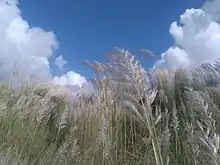Saccharum spontaneum
Saccharum spontaneum (wild sugarcane,[1] kans grass) is a grass native to the Indian Subcontinent. It is a perennial grass, growing up to three meters in height, with spreading rhizomatous roots.[2][3] Commonly found in the Terai-Duar savanna and grasslands, a lowland ecoregion at the base of the Himalaya range in Pakistan, Nepal, India, Bangladesh and Bhutan. Kans grass colonises exposed silt plains created each year by the retreating monsoon floods, forming almost pure stands on the lowest portions of the floodplain. Kans grasslands are an important habitat for the Indian rhinoceros (Rhinoceros unicornis). In Nepal, kans grass is harvested to thatch roofs or fence vegetable gardens.
| Kans grass | |
|---|---|
 | |
| Scientific classification | |
| Kingdom: | Plantae |
| Clade: | Tracheophytes |
| Clade: | Angiosperms |
| Clade: | Monocots |
| Clade: | Commelinids |
| Order: | Poales |
| Family: | Poaceae |
| Subfamily: | Panicoideae |
| Genus: | Saccharum |
| Species: | S. spontaneum |
| Binomial name | |
| Saccharum spontaneum | |

The ability to quickly colonize disturbed soil has allowed it to become an invasive species that takes over croplands and pasturelands, as has been documented in the Republic of Panama.[4]
Uses
Saccharum spontaneum has a considerable number of regional names in the Indian Subcontinent, kash (কাশ) being common in Bengali, kohuwa (কঁহুৱা) in Assamese, kasatandi (କାଶତଣ୍ଡୀ) in Odia and Kasi (खासि) in Bodo. The use of Saccharum spontaneum is also found in Ayurveda.[5][6]
The plant has hybridized with Saccharum officinarum, a domesticated sugarcane. The hybridization has produced Saccharum barberi and Saccharum sinense.[7]
A set of species-related orphane genes, Saccharum spontaneum exhibits exceptional resistance to biotic stresses such as nematodes, fungi, bacteria and other pests and diseases, and abiotic stresses such as cold, drought, salinity and nutritionally deficient soil.[8]
References
- USDA, NRCS (n.d.). "Saccharum spontaneum". The PLANTS Database (plants.usda.gov). Greensboro, North Carolina: National Plant Data Team. Retrieved 26 October 2015.
- "Archived copy" (PDF). Archived from the original (PDF) on 2013-12-03. Retrieved 2013-12-03.
{{cite web}}: CS1 maint: archived copy as title (link) - "www.assamplants.com { A database of medicinal plants of Assam for a green future }". assamplants.com. Archived from the original on 2011-05-07.
- Saltonstall, Kristin; Bonnett, Graham D.; Aitken, Karen S. (2020-11-21). "A perfect storm: ploidy and preadaptation facilitate Saccharum spontaneum escape and invasion in the Republic of Panama". Biological Invasions. 23 (4): 1101–1115. doi:10.1007/s10530-020-02421-3. ISSN 1573-1464.
- Pankaj Oudhia (2001-3)
- "Assam Plants". assamplants.com. Archived from the original on 2013-12-07.
- Paterson, Andrew H.; Moore, Paul H.; Tom L., Tew (2012). "The Gene Pool of Saccharum Species and Their Improvement". In Paterson, Andrew H. (ed.). Genomics of the Saccharinae. Springer Science & Business Media. pp. 43–72. ISBN 9781441959478.
- Cardoso-Silva, Cláudio Benício; Aono, Alexandre Hild; Mancini, Melina Cristina; Sforça, Danilo Augusto; Da Silva, Carla Cristina; Pinto, Luciana Rossini; Adams, Keith L.; De Souza, Anete Pereira (2022). "Taxonomically Restricted Genes Are Associated with Responses to Biotic and Abiotic Stresses in Sugarcane (Saccharum SPP.)". Frontiers in Plant Science. 13. doi:10.3389/fpls.2022.923069.
External links
 Data related to Saccharum spontaneum at Wikispecies
Data related to Saccharum spontaneum at Wikispecies